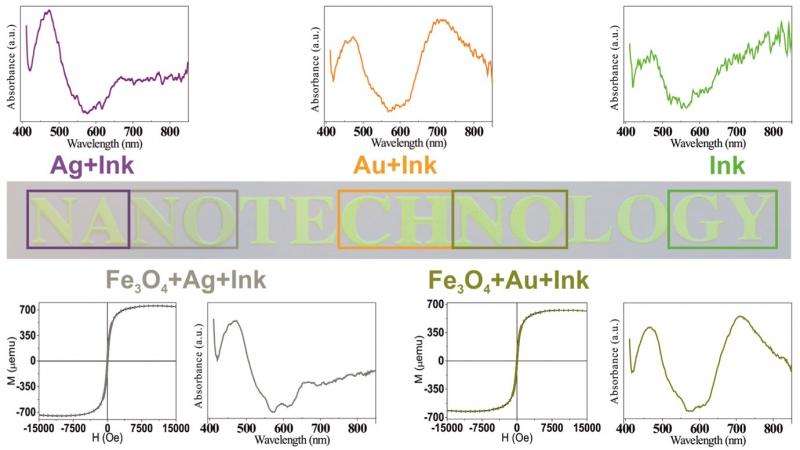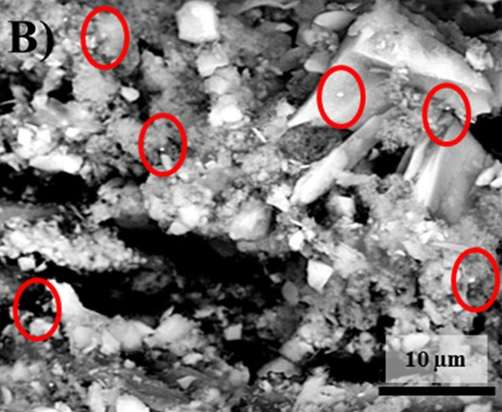A paper with the word “Nanotechnology,” where different pairs of letters are printed with different combinations of overlapping nanoparticle inks. Credit: Campos-Cuerva, et al. ©2016 IOP Publishing
(Phys.org)—Researchers have demonstrated that transparent ink containing gold, silver, and magnetic nanoparticles can be easily screen-printed onto various types of paper, with the nanoparticles being so small that they seep into the paper's pores. Although invisible to the naked eye, the nanoparticles can be detected by the unique ways that they scatter light and by their magnetic properties. Since the combination of optical and magnetic signatures is extremely difficult to replicate, the nanoparticles have the potential to be an ideal anti-counterfeiting technology.
The researchers, Carlos Campos-Cuerva, Maciej Zieba, and coauthors at the University of Zaragoza in Zaragoza, Spain, and CIBER-BBN in Madrid, Spain, have published a paper on the anti-counterfeiting nanoparticle ink in a recent issue of Nanotechnology.
"We believe that it would be interesting to sell to different manufacturers their own personalized ink providing a specific combination of signals," coauthor Manuel Arruebo at the University of Zaragoza and CIBER-BBN told Phys.org. "The nanoparticle-containing ink could then be used to mark a wide variety of supports including paper (documents, labels of wine, or drug packaging), plastic (bank or identity cards), textiles (luxury clothing or bags), and so on."
Whereas previous methods of using nanoparticles as an anti-counterfeiting measure often require expensive, sophisticated equipment, the new technique is much simpler. The researchers attached the nanoparticles to the paper by standard screen-printing of transparent ink, and then authenticated the samples using commercially available optical and magnetic sensors.
"We demonstrated that the combination of nanomaterials providing different optical and magnetic properties on the same printed support is possible, and the resulting combined signals can be used to obtain a user-configurable label, providing a high degree of security in anti-counterfeiting applications using simple commercially available sensors at a low cost," Arruebo said.
An SEM micrograph of paper printed with nanoparticle-based ink, with the nanoparticles circled in red. Credit: Campos-Cuerva, et al. ©2016 IOP Publishing
Although the nanoparticle ink is easy for the researchers to fabricate, attempting to replicate these authentication signals would be extremely difficult for a forger because the signals arise from the highly specific physical and chemical characteristics of the nanoparticles. Replicating the exact type, size, shape, and surface coating requires highly precise fabrication methods and an understanding of the correlation between the signals and these characteristics.
Making replication even more complicated is the fact that the combined optical and magnetic nanoparticles are printed on top of each other in the same spot, and this overlap creates an even more complex signal. Another advantage of the new technique is that the nanoparticles are able to withstand extreme temperatures and humidity under accelerated weathering conditions.
One of the greatest applications of the technology may be to prevent forgery of pharmaceutical drugs. Counterfeit medicine—which includes drugs that have incorrect or no active ingredients, as well as drugs that are intentionally mislabeled—is a growing problem throughout the world. The researchers plan to pursue such applications as well as further increase the security of the technology in future work.
"We plan to add more physical signals to the same tag by combining nanoparticles which could provide optical, magnetic, and electrical signals, etc., on the same printed spot," Arruebo said.
More information: Carlos Campos-Cuerva, et al. "Screen-printed nanoparticles as anti-counterfeiting tags." Nanotechnology. DOI: 10.1088/0957-4484/27/9/095702
Journal information: Nanotechnology
© 2016 Phys.org

























